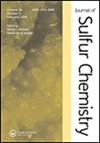Fe3S2 cluster complexes containing aminodiphosphine ligand: synthesis, characterization, crystal structures and electrochemical properties
IF 2.1
3区 化学
Q3 CHEMISTRY, MULTIDISCIPLINARY
引用次数: 0
Abstract
In this article, six new Fe3S2 cluster complexes Fe3(µ3S)2(CO)7[(Ph2P)2NR] (1-6) (R = (CH2)2CH3, CH(CH3)2, (CH2)3CH3, CH2CH(CH3)2, p-C6H4CCH and m-C6H4CCH) were successfully synthesized by reactions of Fe3S2(CO)9 and the corresponding aminodiphosphines under refluxing toluene. Meanwhile, treatment of Fe3S2(CO)9 and (Ph2P)2NCH(CH3)Ph afforded two new Fe3S2 cluster complexes Fe3(µ3-S)2(CO)7[(Ph2P)2NCH(CH3)Ph] (7) and Fe3(µ3-S)2(CO)7[(κ2-Ph2P)2NCH(CH3)(Ph)] (8). Complexes 1–8 were characterized by elemental analysis, FT-IR, NMR spectroscopy, and especially X-ray crystallography. The elctrochemical properties were investigated by cyclic voltammetry, showing that they all have electrocatalytic ability for the reduction of protons to H2.
含氨基二膦配体Fe3S2簇状配合物的合成、表征、晶体结构和电化学性能
摘要本文研究了六种新的Fe3S2簇合物Fe3(µ3S)2(CO)7[(Ph2P)2NR](1-6)(R = 以Fe3S2(CO)9和相应的氨基二膦在甲苯回流下反应,成功合成了(CH2)2CH3、CH(CH3)2、(CH2。同时,对Fe3S2(CO)9和(Ph2P)2NCH(CH3)Ph进行处理,得到两种新的Fe3S2簇合物Fe3(µ3-S)2(CO)7[(Ph2P)2NCH(CH3。配合物1-8通过元素分析、FT-IR、NMR光谱,特别是X射线晶体学进行了表征。通过循环伏安法研究了它们的电化学性质,表明它们都具有将质子还原为H2的电催化能力。图形摘要
本文章由计算机程序翻译,如有差异,请以英文原文为准。
求助全文
约1分钟内获得全文
求助全文
来源期刊

Journal of Sulfur Chemistry
CHEMISTRY, MULTIDISCIPLINARY-
CiteScore
4.10
自引率
9.10%
发文量
38
审稿时长
6-12 weeks
期刊介绍:
The Journal of Sulfur Chemistry is an international journal for the dissemination of scientific results in the rapidly expanding realm of sulfur chemistry. The journal publishes high quality reviews, full papers and communications in the following areas: organic and inorganic chemistry, industrial chemistry, materials and polymer chemistry, biological chemistry and interdisciplinary studies directly related to sulfur science.
Papers outlining theoretical, physical, mechanistic or synthetic studies pertaining to sulfur chemistry are welcome. Hence the target audience is made up of academic and industrial chemists with peripheral or focused interests in sulfur chemistry. Manuscripts that truly define the aims of the journal include, but are not limited to, those that offer: a) innovative use of sulfur reagents; b) new synthetic approaches to sulfur-containing biomolecules, materials or organic and organometallic compounds; c) theoretical and physical studies that facilitate the understanding of sulfur structure, bonding or reactivity; d) catalytic, selective, synthetically useful or noteworthy transformations of sulfur containing molecules; e) industrial applications of sulfur chemistry; f) unique sulfur atom or molecule involvement in interfacial phenomena; g) descriptions of solid phase or combinatorial methods involving sulfur containing substrates. Submissions pertaining to related atoms such as selenium and tellurium are also welcome. Articles offering routine heterocycle formation through established reactions of sulfur containing substrates are outside the scope of the journal.
 求助内容:
求助内容: 应助结果提醒方式:
应助结果提醒方式:


